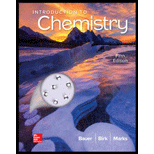
Concept explainers
(a)
Interpretation:
The key term for: “The way in which the various regions of secondary structure in a protein are arranged into a three-dimensional shape�, is to be given.
(b)
Interpretation:
The key term for: “One of a class of
(c)
Interpretation:
The key term for: “An organic molecule containing an
(d)
Interpretation:
The key term: “The form of RNA takes the genetic code from DNA and carries it to the ribosomes�, is to be given.
(e)
Interpretation:
The key term for: “One of a class of organic
(f)
Interpretation:
The key term for: “The structure that results from the association of two or more polypeptide chains in a protein�, is to be given.
(g)
Interpretation:
The key term for: “A series of three bases in a
(h)
Interpretation:
The key term for: “The secondary structure adopted by many proteins, in which the protein chain is twisted into a helix�, is to be given.
(i)
Interpretation:
The key term for: “The secondary structure adopted by protein in which the protein chains are lined up beside one another in the form of a sheet�, is to be given.
(j)
Interpretation:
The key term for: “A
(k)
Interpretation:
The key term for: “The linkage that forms between carboxylic acid
(l)
Interpretation:
The key term for: “The process of synthesizing various types of RNA molecules in the nucleus using a DNA molecule as a template�, is to be given.
Want to see the full answer?
Check out a sample textbook solution
Chapter 17 Solutions
INTRODUCTION TO CHEMISTRY(LL)-W/CONNECT
- (a) How many tripeptides can be made from glycine, alanine, and leucine, using each amino acid only once per tripeptide? (b) Write the structural formulas of these tripeptides and name them in the shorthand abbreviation used for showing amino acid sequences.arrow_forwardThere are six isomeric tripeptides that contain valine, tyrosine, and glycine. Name them using both three- and one-letter abbreviations.arrow_forwardIdentifying Amino Acids Which of the following molecules is an amino acid?arrow_forward
- Fill in the blanks in the following statements: aThe order of the amino acids in a protein is the ______ structure of that protein. The _______ of the backbone chain of a protein is the secondary structure of that protein. The tertiary structure of a protein describes the ______ of the secondary structure. b Hydrogen bonding between the oxygen atoms of carbonyl groups and the hydrogen atoms of amide groups in the same protein chain gives the secondary structure, called the ______. c Hydrogen bonding between the oxygen atoms of carbonyl groups and the hydrogen atoms of amide groups in the adjacent protein chain gives the secondary structure, called the ______.arrow_forwardWhich of the following describes the primary structure of proteins? a. The collective shape assumed by all of the chains in a protein containing multiple chains. b. The folding of an individual protein molecule. c. The regular repeated shape of the protein molecules backbone. d. The sequence of amino acids bonded together by peptide bonds.arrow_forwardDraw the Lewis diagram for the DNA fragment that is complementary to the guanine-thymine-adenine DNA fragment.arrow_forward
- On complete hydrolysis, a polypeptide gives two alanine, one leucine, one methionine, one phenylalanine, and one valine residue. Partial hydrolysis gives the following fragments: Ala-Phe, Leu-Met, Val-Ala, Phe-Leu. It is known that the first amino acid in the sequence is valine and the last one is methionine. What is the complete sequence of amino acids?arrow_forwardWhat element is always present in proteins that is seldom present in carbohydrates and lipids?arrow_forwardIn a pleated sheet secondary structure for a protein a. describe the general shape of the protein backbone b. describe the general locations for the amino acid R groupsarrow_forward
- To which family of mirror-image isomers do nearly all naturally occurring amino acids belong?arrow_forward. How many possible primary structures exist for a small polypeptide containing four individual amino acids?arrow_forward21-90 To what extent do lipids and carbohydrates play structural roles in living organisms? Do these roles differ in plants and in animals?arrow_forward
 Introductory Chemistry: An Active Learning Approa...ChemistryISBN:9781305079250Author:Mark S. Cracolice, Ed PetersPublisher:Cengage Learning
Introductory Chemistry: An Active Learning Approa...ChemistryISBN:9781305079250Author:Mark S. Cracolice, Ed PetersPublisher:Cengage Learning ChemistryChemistryISBN:9781305957404Author:Steven S. Zumdahl, Susan A. Zumdahl, Donald J. DeCostePublisher:Cengage Learning
ChemistryChemistryISBN:9781305957404Author:Steven S. Zumdahl, Susan A. Zumdahl, Donald J. DeCostePublisher:Cengage Learning Chemistry: An Atoms First ApproachChemistryISBN:9781305079243Author:Steven S. Zumdahl, Susan A. ZumdahlPublisher:Cengage Learning
Chemistry: An Atoms First ApproachChemistryISBN:9781305079243Author:Steven S. Zumdahl, Susan A. ZumdahlPublisher:Cengage Learning
 Chemistry for Today: General, Organic, and Bioche...ChemistryISBN:9781305960060Author:Spencer L. Seager, Michael R. Slabaugh, Maren S. HansenPublisher:Cengage Learning
Chemistry for Today: General, Organic, and Bioche...ChemistryISBN:9781305960060Author:Spencer L. Seager, Michael R. Slabaugh, Maren S. HansenPublisher:Cengage Learning Chemistry: Principles and ReactionsChemistryISBN:9781305079373Author:William L. Masterton, Cecile N. HurleyPublisher:Cengage Learning
Chemistry: Principles and ReactionsChemistryISBN:9781305079373Author:William L. Masterton, Cecile N. HurleyPublisher:Cengage Learning





